A central Philippine province declared a state of calamity yesterday as a volcano spewed lava that reached the limits of a six-km radius no-go zone and spread ash on nearby farming villages.
Mount Mayon, a volcano in Albay province in the coconut-growing central Bicol region, has been erupting since Saturday and the number of people fleeing their homes had more than doubled yesterday to about 25,000, said Albay Governor Al Francis Bichara.
The National Disaster Risk Reduction and Management Council gave a smaller estimate, saying there were close to 22,000 evacuees.
Placing the province under a state of calamity will give the province access to extra funds.
“This kind of eruption, it will take about weeks, so we have to sustain the operations in the evacuation centres,” Bichara told ANC news channel.
“We need to use the calamity funds.”
The Philippine Institute of Volcanology and Seismology (Phivolcs) said it had recorded nine more tremors, four of which accompanied lava fountains, as pressure leads to lava flows and ash plumes.
It reiterated that the activity signified a possible hazardous eruption within weeks or even days from the near perfectly cone-shaped volcano.
The provincial government has also expanded its suspension of school classes to more towns around the 2,462-metre volcano, about 340km southeast of Manila.
Class suspensions have allowed the government to use schools as temporary shelters.
Meanwhile, an elderly man died in the Philippines after being evacuated from his home as the country’s most active volcano ejected fiery lava, police said yesterday.
The 81-year-old man was among the evacuees staying at an elementary school in Tabaco City, according to Chief Inspector Arthur Gomez, a spokesman for the provincial police.
“Unfortunately earlier today, his body was discovered lifeless,” Gomez said, adding that the man appeared to have died of ailments related to old age.
The volcano’s fiery display has drawn tourists to Albay province,where they observe the lava flows from a safe distance, while mandatory evacuation of residents was enforced within a seven kilometre danger zone from Mayon’s summit.
“We have witnessed lava fountaining, that’s why we have additional families who evacuated due to the threat,” said Romina Marasigan, spokeswoman for the national disaster relief agency.
“There are still signs of unrest,” she added. “We also observed phreatic eruptions and spewed ash so it remains active.” The 2,463-metre volcano has erupted about 50 times since 1616.
The last deadly eruption was in May 2013, in which five hikers were killed and seven people injured. Mayon’s most violent eruption was in 1814, when more than 1,200 people were killed and a town was buried in volcanic mud. An eruption in 1993 killed 79 people.

Cloud-covered Mayon volcano spews ash as it erupts near the Philippine city of Legazpi in Albay province, early yesterday.
